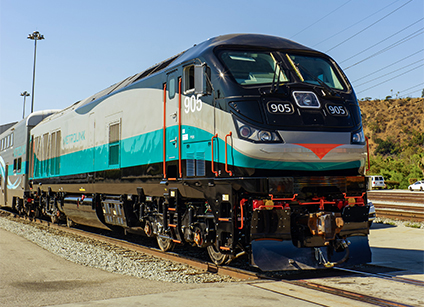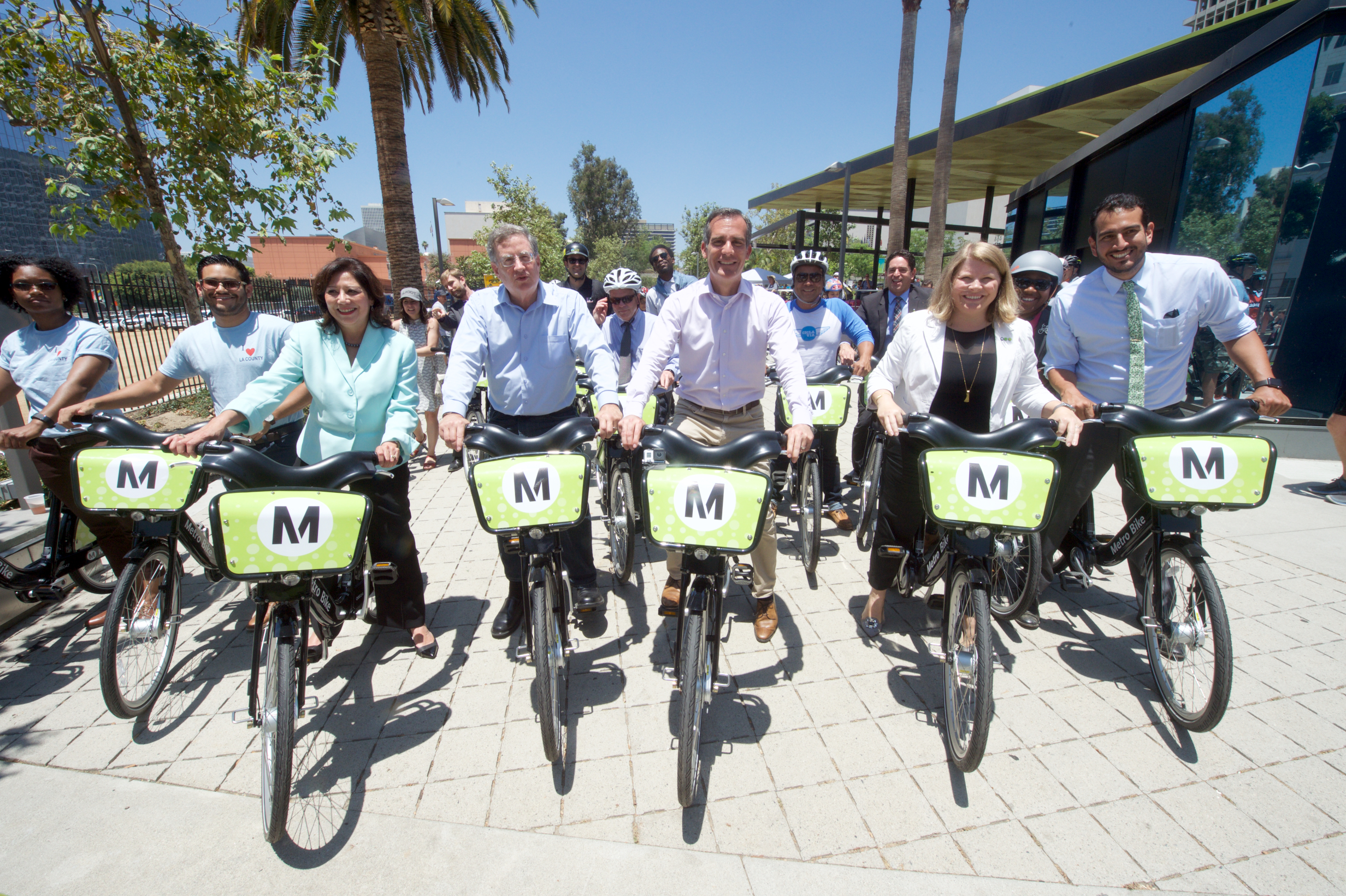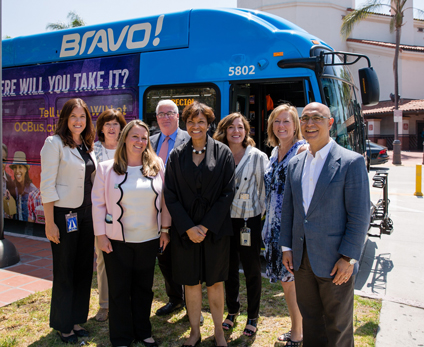Mobility 21 Summit Agenda Announced
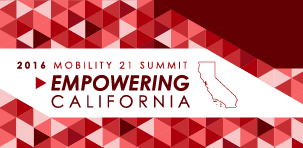 The 2016 Summit agenda is now available to view online! Click here to plan your day:
The 2016 Summit agenda is now available to view online! Click here to plan your day:
- Choose from eight engaging breakout sessions
- Attend our not-to-be-missed general sessions
- Network with more than 100 exhibitors in our expo hall
- Reboot your mind (and cell phone!) in our new Charge & Recharge Station with phone charging stations, seated massages and snacks to energize you throughout the day
AGENDA
- 8-8:45 a.m.: Registration Opens, Breakfast Served
- 8:45-10:15 a.m.: Opening General Session
- 10:15-10:45 a.m.: Morning Networking Break in Expo
- 10:45-11:45 a.m.: Morning Breakout Sessions
- AM 1: Chairmans’ Roundtable
- AM 2: Getting California Connected: Self-Driving Cars and Beyond
- AM 3: Reversing the Trends of Declining Transit Ridership
- AM 4: From the Ports to Your Front Porch: The Changing Landscape of Logistics
- 12-1:15 p.m.: Luncheon General Session
- 1:15-1:30 p.m.: 15 Minute Break
- 1:30-2:30 p.m.: Afternoon Breakout Sessions
- PM 1: Insider’s Look: California’s 2017 Policy Impacts
- PM 2: A New Transportation Paradigm for California?
- PM 3: Next Gen Mobility in a Shared Economy World
- PM 4: NFL and Mega Events: Revitalizing Transportation in the Region
- 2:30-3 p.m.: Afternoon Networking Break, Expo Hall
- 3-4 p.m.: Closing General Session
Mobility 21 Advisory Board Member Spotlight:
Maureen “Mo” Hayes
Government Relations and Business Development Leader, HNTB Corporation
 Maureen “Mo” Hayes is Government Relations and Business Development Leader for HNTB Corporation’s West Division, based in the firm’s Orange County office and is responsible for coordinating interactions with government officials and key stakeholders to achieve the firm’s strategic goals. She has more than 25 years of experience in managing public policy and business development for complex infrastructure programs and projects throughout California and the western United States. Mo joined the Mobility 21 Advisory Board in June 2016.
Maureen “Mo” Hayes is Government Relations and Business Development Leader for HNTB Corporation’s West Division, based in the firm’s Orange County office and is responsible for coordinating interactions with government officials and key stakeholders to achieve the firm’s strategic goals. She has more than 25 years of experience in managing public policy and business development for complex infrastructure programs and projects throughout California and the western United States. Mo joined the Mobility 21 Advisory Board in June 2016.
Mo’s history of high-profile transportation projects include working with the Los Angeles County Metropolitan Transportation Authority (Metro), Metro Gold Line Foothill Extension Construction Authority, and the Exposition Metro Line Construction Authority; Orange County Transportation Authority (OCTA); Riverside County Transportation Commission (RCTC); San Bernardino Associated Governments (SANBAG); Los Angeles World Airports; John Wayne Airport; Ports of Long Beach and Los Angeles; and others. She has also had extensive involvement on the California High-Speed Rail program, ranging from initial planning through construction.
Mo’s knowledge of transportation issues and her affiliation and leadership in the most influential civic organizations in the state support her ability to serve as a trusted advisor to local, regional, state and federal entities, helping them drive policies and legislation to improve transportation infrastructure throughout the Western U.S. She has been involved with advocacy trips to Sacramento and Washington DC for over 20 years.
With a reputation as a problem solver, Mo constantly works to find the most effective and efficient method of project delivery. She has been instrumental in increasing the amount of alternative delivery methods such as design-build and CM at-risk. She expertly leverages her relationships on the local, state, and federal levels and understands the unique interaction required for complex projects to ensure good public policy goals are achieved.
Prior to joining HNTB, Mo served as senior vice president for an engineering consulting firm where she was responsible for government relations activities and developing new business opportunities for complex infrastructure projects in the state.
In addition to Mobility 21, Mo has extensive professional and civic affiliations that include serving on the board of the Los Angeles Area Chamber of Commerce where she chairs the Transportation and Goods Movement Council, and the Association of California Cities – Orange County. She serves as Vice-chair for the Infrastructure Committee for the Orange County Business Council.
Mobility 21 Advisory Board Member Spotlight:
David Warner
Senior Vice President, Southern California Infrastructure Leader, Parsons
 Dave Warner is responsible for partnering with regional leaders, stakeholders and clients to strategically advance infrastructure in Southern California. He guides Parsons’ investment in the region through business development, political engagement and professional organization participation in order to provide top talent, innovative solutions and emerging technologies to Parsons’ clients and projects. Dave is a Senior Vice President who has been in charge of Parsons’ California operations for the last two years, including the firm’s relationships with Metro, OCTA, SANBAG, RCTC, City of Bakersfield, City of Ontario, SANDAG, Caltrans and various local agencies. Dave also serves as principal-in-charge for several of the region’s largest transportation projects. In his new role as Southern California infrastructure leader, Dave will specifically focus on Southern California.
Dave Warner is responsible for partnering with regional leaders, stakeholders and clients to strategically advance infrastructure in Southern California. He guides Parsons’ investment in the region through business development, political engagement and professional organization participation in order to provide top talent, innovative solutions and emerging technologies to Parsons’ clients and projects. Dave is a Senior Vice President who has been in charge of Parsons’ California operations for the last two years, including the firm’s relationships with Metro, OCTA, SANBAG, RCTC, City of Bakersfield, City of Ontario, SANDAG, Caltrans and various local agencies. Dave also serves as principal-in-charge for several of the region’s largest transportation projects. In his new role as Southern California infrastructure leader, Dave will specifically focus on Southern California.
Dave has a broad background in project delivery that includes planning and policy through construction and alternative project delivery for waterfront, roadway, and transit projects. Most notably, Dave managed the environmental phase for the world’s longest floating bridge, and he managed the delivery of the world’s longest urban seawall replacement. Dave recently served on Seattle Mayor Ed Murray’s appointed Women- and Minority- Owned Businesses Advisory Committee to significantly advance the region’s commitment to diverse and inclusive business opportunities. His collaborative approach to operations, sales, and project delivery will further Parsons’ innovation and energy around infrastructure in the region.
Summit Platinum Sponsor Spotlight:
AECOM
![]() The AECOM approach: Sustainable, multi-modal long-term transportation solutions that help to make the world a better place
The AECOM approach: Sustainable, multi-modal long-term transportation solutions that help to make the world a better place
AECOM, a premier, fully integrated infrastructure firm, has been connecting communities with innovative transportation solutions for decades. Our teams of engineers, architects, planners and program managers are delivering cutting-edge transportation solutions for all of the region’s transportation providers, including Metro, Metrolink, OCTA and the Exposition and Foothill Construction Authorities.
This experience has given AECOM a unique perspective on how cities should wrestle with infrastructure challenges spawned by population growth and aging infrastructure. Transportation solutions, in particular, require integrated, sustainable, multi-modal and long-term strategies.
Getting there together: Enhancing transportation systems to move people and business faster.
A city’s economy moves at the pace of its transportation network. Efficient transportation speeds the flow of people, ideas and commerce. Airports and seaports are global gateways. Roads and rail establish regional connections. Bike and walking routes provide important first and last-mile connections to our regional transportation systems while also providing healthy, inexpensive and fun mobility options. Thoughtful access must be built into a city’s fabric.
In helping to enhance the region’s ground transportation infrastructure, AECOM has become a trusted partner with Metro and has improved mobility for residents through our contributions on every project that the agency has built in the past 25 years. For example, by connecting the Metro Gold, Blue, and Expo light rail transit (LRT) lines, the Regional Connector Transit Project will dramatically improve access to local and regional destinations across the area. AECOM, as part of a joint venture, provided advanced conceptual and preliminary engineering, and is currently providing engineering support during construction of the 1.9-mile underground alignment through downtown Los Angeles.
Transportation and the cities of tomorrow
AECOM’s forward-looking approach examines how innovative transportation technologies will help to shape the cities of tomorrow. Simply doing things the way they’ve always been done means looking backwards, not forwards. AECOM is at the forefront of revolutionary technologies such as the Hyperloop, a transportation project that is generating an array of innovative ideas that will have lasting impact on how future transportation challenges are addressed.
Urban densification and aging infrastructure insure that there will be no shortage of transportation challenges for cities. A holistic strategy that incorporates solutions not typically considered in infrastructure management will help cities deliver sustained growth and prosperity.
Summit Gold Sponsor Spotlight:
Costin Outreach Group
 Sara Costin of Costin Outreach Group (COG) has assisted Mobility 21 for the past four years. Her name may be familiar to you because she is responsible for managing registration, the expo and volunteers at our annual Summit.
Sara Costin of Costin Outreach Group (COG) has assisted Mobility 21 for the past four years. Her name may be familiar to you because she is responsible for managing registration, the expo and volunteers at our annual Summit.
 Sara is President at Costin Outreach Group, a communications firm that engages stakeholders to participate in the public process. From project initiation to construction, COG has developed and executed outreach programs for dozens of signature transportation projects that have transformed the landscape of Southern California.
Sara is President at Costin Outreach Group, a communications firm that engages stakeholders to participate in the public process. From project initiation to construction, COG has developed and executed outreach programs for dozens of signature transportation projects that have transformed the landscape of Southern California.
COG’s philosophy is that every stakeholder in every community should be involved in delivering a result. Their expertise is rooted in understanding the details and lexicon of your project. From reading plans and profiles to executing the outreach goals of CEQA, COG translates the technical documents so that every stakeholder is equipped to engage in a dialogue with you and your community.
COG’s team has worked for metropolitan planning organizations, rail authorities, transit districts, counties and cities throughout California. Their work has spanned from Orange County to Riverside County to Kern County, from the San Fernando Valley to the San Gabriel Valley and all of the cities in between including Anaheim, Santa Monica, Los Angeles, Santa Clarita and Bakersfield.
Summit Gold Sponsor Spotlight:
Metrolink
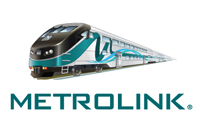 Metrolink once again has partnered with Mobility 21 to allow conference attendees to ride Metrolink free of charge with their conference registration confirmation.
Metrolink once again has partnered with Mobility 21 to allow conference attendees to ride Metrolink free of charge with their conference registration confirmation.
As a coalition bringing together various stakeholders in pursuit of regional solutions to transportation challenges, Mobility 21 has similar goals to Metrolink.
The commuter rail agency serves the same counties (Los Angeles, Orange, Riverside, San Bernardino, San Diego and Ventura) that Mobility 21 advocates for in achieving shared missions.
Joining Summit hosts and member agencies Metro, OCTA, RCTC, SANBAG and VCTC, Metrolink implemented a historic safety initiative, Positive Train Control (PTC). It is only through the collaborative efforts of rail partners BNSF, Union Pacific, Amtrak and NCTD that this monumental effort became a reality.
Thanks to the efforts of CARB, AQMD, CalSTA, Caltrans and more, Metrolink also became the first in the nation to purchase Tier IV locomotives. These engines have 84% more horsepower, save 8% more fuel compared to Tier 0 locomotives, and will be equipped with PTC and Crash Energy Management (CEM).
Safety advancements such as PTC, CEM, and inward-facing cameras are just part of Metrolink’s dedication to safety, while providing an outstanding passenger experience on every ride with safe, clean, dependable and on-time performance.
Once Mobility 21 passengers reach the Anaheim-ARTIC Station, they can transfer at no additional cost to an ART shuttle between the station and Disneyland Hotel. Metrolink is proud to be a partner of the Mobility 21 Summit, offering a transportation option to its attendees.
Photo: Gary Leonard/Metro
Hundreds of Bicyclists Converge on
Downtown Los Angeles Streets
Los Angeles has officially joined the bike share revolution. Earlier this month, hundreds of people who live, work and play in L.A. converged in Grand Park to launch Metro Bikes, an eagerly anticipated, groundbreaking new bike sharing network that will consist of up to 1,000 shared bicycles at up to 65 stations throughout the downtown area.
The $11 million project is the joint product of L.A. Metro and the City of Los Angeles, and is the first pilot effort to establish bike sharing throughout Los Angeles County that could potentially bring up to 4,000 bicycles to communities region-wide.
“The much anticipated launch of bike sharing in Downtown Los Angeles is the latest salvo in Metro’s ongoing transportation revolution,” said John Fasana, Duarte City Council Member and Metro Board Chair. “Our new transportation services are eroding the exclusive domain of the automobile and giving everyone more affordable, active and sustainable alternatives.”
Metro worked closely with the City of Los Angeles to strategically place bike share stations at major transit hubs and key destinations of most benefit to people living, working and playing in the downtown area. Bike share stations are located on both sides of Union Station, L.A. City Hall, Grand Park, the L.A. Convention Center, South Park, Chinatown, the Arts District, the Fashion District, Little Tokyo and other prime spots, most of them within a couple blocks of each other.
“Downtown L.A. is a fascinating place to explore on two wheels,” said Los Angeles Mayor and Metro Board Second Vice Chair Eric Garcetti. “Metro Bike Share gives Angelenos and visitors an easy, affordable way to experience some of our city’s most incredible sights.”
Many bike share stations are located close to the Metro Rail and Bus network, giving transit riders direct access to Metro Bikes to easily combine bicycle and transit trips. The system is the first in the United States to be operated by a transit agency and the first to use a single fare card, the TAP card, for both the transit system and bike share system.
“Our Metro Bike Share program will not only create a connected bicycle system, it will connect people to one another and the distinct neighborhoods that make Downtown Los Angeles one of the most vibrant urban cores in the nation,” said Los Angeles City Councilmember José Huizar. “We need to continue to implement policy like this that prioritizes pedestrian, bicycle and public-transit use as much as automobiles – that is the model for the new Los Angeles.”
Downtown Los Angeles is the ideal area to launch bike sharing. Downtown is the largest employment center in the county, has an exploding residential population, and is home to ubiquitous and growing transit system. It is also a top tourist destination, with major world-class sports, entertainment, dining, cultural and tourist destinations throughout numerous downtown districts. Metro and the city selected bike share locations that created better access to museums, libraries, schools, retail, employment, and residential areas.
“Bike Sharing puts downtown at your pedals – from the murals of the Arts District to the Chinatown gates to Skyspace in the Financial District,” said Seleta Reynolds, LADOT General Manager. “We want it to help people connect the dots in a fun and healthy way.”
To use the bike share system, customers can purchase a monthly or annual flex pass at www.metro.net/bikeshare. New customers will receive their TAP card in the mail. Existing TAP card holders have the option of registering their current TAP card in the system and simply adding bike share access to it. Starting August 1, people will be able to walk up to a bike share station and check out a bike by paying with a credit card.
Pass holders will use their Metro bike share-registered TAP card to access any Metro Bike from a dock at a station. Bike share-registered TAP cards identify each user to both Metro bike share and Metro transit lines. As with all TAP cards, transit fares can be loaded onto a bike share-registered TAP card at any Metro ticket vending machine, online at taptogo.net or at any of the hundreds of TAP vending locations across the county.
Users can download a special Metro Bike Share App available on iOS and Android that will enable them to buy a pass, check bike and dock availability, and find the nearest station to their location, among other features.
The Metro bike share fare structure is designed to be flexible and affordable for all users. The agency has created three simple pass options:
- A 30-day pass is $20. All trips 30 minutes or less are free and $1.75 per 30 minutes thereafter. This pass option is best if the user expects to take more than five trips per month. People use their registered TAP card to get bikes directly from docks and the pass renews 30 days after initial purchase.
- A Flex Pass is $40 per year. All trips 30 minutes or less are $1.75 and $1.75 per 30 minutes thereafter. This option is best if users expect to take two to five trips per month or want the convenience of using their TAP card to get a bike directly from the dock.
- A Walk-Up is $3.50 for 30 minutes. This option will be available starting August 1. All trips 30 minutes or less are $3.50, and $3.50 per 30 minutes thereafter. An introductory 50 percent discount rate will be offered in August-September. This option is best for tourists and visitors to downtown LA. Users can pay per trip using their credit card at any station kiosk. No TAP card is needed for the Walk-Up.
Metro has ensured the system is equitable for all users. The agency distributed 40,000 Annual Flex Pass coupons for Metro Rider Relief participants to try the system at a low cost. The program also has grant funding for Metro partners to conduct outreach to disadvantaged communities and to measure equity as the system grows.
The program is planned to expand to many other communities within L.A. County including Pasadena, North Hollywood, Burbank, Huntington Park, Venice, Marina Del Rey, East L.A., and San Gabriel Valley to create a regionwide system of more than 4,000 bicycles pending board approval.
The system will be operated by Bicycle Transit Systems, with bikes and stations provided by BCycle, a unit of Trek Bicycles of Wisconsin. These companies have successfully launched and/or operate more than 40 bike share systems in metropolitan areas in the United States and abroad.
“Bicycle Transit Systems is committed to helping Metro Bike Share become a culture-changing blockbuster, by providing customers with an incredible, and safe, customer experience by Angelenos for Angelenos,” said Allison Cohen, CEO of BTS. “Metro Bike Share headquarters are based in Downtown L.A., and our diverse set of employees looks forward to providing Los Angeles County a safe and world-class service that we believe will expand rapidly.”
Stay informed by following Metro on The Source and El Pasajero at metro.net, facebook.com/losangelesmetro, twitter.com/metrolosangeles and twitter.com/metroLAalerts and instagram.com/metrolosangeles.
News: Southern California
Left Out of FASTLANE Grants
On July 15, as reported by the Long Beach Press-Telegram, Rep. Janice Hahn and 15 other Southern California Congressional members wrote to U.S. Secretary of Transportation Anthony Foxx demanding why the region was shut out of a new federal transportation grant aimed at improving freight movement to and from ports, highways and rail. Sixteen projects in the region, including those from the ports of Los Angeles and Long Beach, were submitted to the new FASTLANE grant program. The lawmakers want to make sure that in future rounds, funding for freight infrastructure gets prioritized, which may have not been the case this round. The L.A. Times Editorial Board also took issue with the U.S. Department of Transportation, saying that the region is too important not to invest in – the value of the goods moving through the ports of Los Angeles and Long Beach is nearly $400 billion.
Federal officials tour the new limited-stop bus route, Santa Ana Regional Transportation Center, OC Streetcar and Pacific Surfliner with OCTA staff members.
FTA Officials Tour OCTA Transit Projects
Two top Federal Transit Administration (FTA) officials recently met with executives from the Orange County Transportation Authority to get an overview of the latest transportation services and projects underway to keep Orange County moving.
OCTA CEO Darrell Johnson and the agency’s staff hosted FTA Acting Administrator Carolyn Flowers and Vincent Valdes, FTA’s Associate Administrator for Research, Demonstration and Innovation. Flowers and Valdes were in Orange County on June 23 to participate in meetings of the Transportation Research Board’s governing body which oversees transportation cooperative research nationally.
“OCTA is investing heavily in transit projects in the coming years and it was an honor to share our efforts with Acting Administrator Flowers and Mr. Valdes,” said OCTA CEO Darrell Johnson. “We look forward to continuing our partnership with the Federal Transit Administration as we continue delivering transportation solutions that keep Orange County residents moving while improving our environment.”
Using one of OCTA’s newly purchased CNG buses, which was partially funded with federal formula assistance from FTA, the group went to the Santa Ana Regional Transportation Center to see the beginning of the of the line of OCTA’s new Bravo! Route 560. This limited-stop service started operating earlier this month to provide faster, more frequent and environmentally cleaner service on a 17-mile route between Santa Ana and the Veterans Administration Hospital in Long Beach.
This new service was made possible through the provision of FTA start-up funding for the first five years of operation from the federal Congestion Mitigation and Air Quality Program. The launch was funded with a $2.3 million grant to OCTA from the Transit and Intercity Rail Program, part of the California’s cap and trade funding program. The program was created to fund capital improvements that cut greenhouse gases by reducing the number of miles that people drive. Buses on the route run on cleaner-burning compressed natural gas.
A brief tour of SARTC was also provided, explaining the significance of Commuter and Intercity passenger rail operations to mobility in Orange County. Beginning in 2013, OCTA was chosen by its corridor transportation agency peers to be the managing agency of the Amtrak Pacific Surfliner service between San Diego, Los Angeles and San Luis Obispo California. Surfliner service provides 22 round trips daily on the corridor, where ridership continues to grow, maintaining its status as the nation’s second busiest passenger rail corridor.
From SARTC, Flowers and Valdez toured the alignment of OCTA’s most recent transit project, the OC Streetcar. When completed, the 4-mile modern streetcar route will provide a rail transit option in Orange County, linking SARTC, through downtown Santa Ana and the county government center to the OCTA’s busiest bus corridor on Harbor Boulevard and the city of Garden Grove.
Rail-roadway grade separation agency acknowledged for contributing to improved quality of life in the region.
ACE Construction Authority Presented with Outstanding Organization Award
The Alameda Corridor-East Construction Authority (ACE) was presented with the 2016 Outstanding Organization Award by a leading public administration society in acknowledgement of the agency’s role in improving the quality of life in the region through its $1.7 billion program of infrastructure improvements along the transcontinental rail lines in the San Gabriel Valley.
“While freight trains reduce the number of large trucks on our congested highways, they also block traffic at crossings – for more than two hours a day at some crossings – and can result in deadly crossing collisions. These impacts were and remain, quite frankly, unacceptable,” said Montebello Councilman and ACE Board Chairman Jack Hadjinian. Southern California is the nation’s leading trade gateway and inland corridor.
Hadjinian accepted the Henry Reining Outstanding Organization Award on behalf of the agency at the annual awards luncheon yesterday of the Southern California Chapter of the America Society for Public Administration (ASPA). The award has been presented annually since 1964 and past recipients include numerous Southland cities, the League of California Cities, the Los Angeles Police Department, Habitat for Humanity LA, and other public and nonprofit organizations.
Established in 1998, ACE is charged with funding and constructing 20 rail-roadway grade separations, where the road goes under or over the railroad, at the most congested and hazardous crossings in the San Gabriel Valley, and safety improvements at the remaining at-grade crossings. More than $1.65 billion in transportation grant funding has been secured for the ACE program and ACE recently opened its ninth grade separation to traffic. Seven grade separations are in active construction and another four grade separations are in design.
Others recognized at the ASPA luncheon include Los Angeles County Metro CEO Phil Washington (Tom Bradley Equal Opportunity Award); Glendale City Council (Winston Crouch Award for Innovation in Government); Los Angeles County Director of Personnel Lisa Garrett (Clarence A. Dykstra Award for Excellence in Government) and ACE Government and Community Relations Director Paul Hubler (Will Baughman Chapter Development Award).
SANDAG Board Puts Measure on November Ballot
 Elected officials countywide who make up the San Diego Association of Governments (SANDAG) Board of Directors voted this month to place a countywide measure on the November 2016 ballot to raise funds to repair roads, relieve highway congestion, improve transit and bike/pedestrian networks, conserve open space and manage land to reduce wildfire risk.
Elected officials countywide who make up the San Diego Association of Governments (SANDAG) Board of Directors voted this month to place a countywide measure on the November 2016 ballot to raise funds to repair roads, relieve highway congestion, improve transit and bike/pedestrian networks, conserve open space and manage land to reduce wildfire risk.
The “San Diego County Road Repair, Transit, Traffic Relief, Safety and Water Quality Measure” is expected to generate $18 billion in dedicated local revenue.
“What we approved today will benefit not just this generation but our children and our grandchildren,” said SANDAG Chair and County Board of Supervisors Chair Ron Roberts. “If we are going to prosper as a region and maintain our quality of life, we need to invest in our infrastructure, our mobility, and our environment with a dedicated source of local revenue – money that Sacramento can’t take away.”
If approved by two thirds of the voters in the region, the measure would increase the sales tax by half a penny over the next 40 years.
Below is a breakdown of the major expenditure categories included in the Ordinance and Expenditure Plan approved by the SANDAG Board:
- $4.3 billion for local infrastructure projects benefiting all 18 cities and unincorporated communities in the County of San Diego. These funds can be used to fix potholes; build streets, sidewalks, and bike paths; implement climate action plans; address shoreline erosion; and clean up storm water runoff pollution. Funds would be distributed to individual jurisdictions based on population proportion.
- $2.6 billion for highways, carpool/managed lanes, and connectors along the I-5, I-8, SR 78, SR 67, SR 56, SR 52, and SR 94, as well as freeway connectors between I-5/SR 56, I-5/SR 78, I-15/SR 78, SR 52/I-805, SR 94/I-15, SR 94/I-805, I-805/SR 15, and SR 94/SR 125.
- $7.5 billion to build and operate transit, including a new Trolley line from San Ysidro to Kearny Mesa; more than a dozen new Rapid routes to provide fast and frequent transit services; and increased frequencies and hours of operation for the Trolley system, COASTER, and local bus routes.
- $2 billion for open space to acquire sensitive habitat to implement the region‘s habitat conservation plans and to better manage preserved open space to reduce wildfire risk.
- $540 million for active transportation to build new bike lanes, sidewalks, and crosswalks, and projects such as underpasses that separate trains and Trolleys from bike and pedestrian crossings.
- $900 million to separate Trolley/rail tracks from vehicle traffic which would improve vehicle and pedestrian safety, as well as efficiency of transit services.
- $178 million for local arterial traffic synchronization to improve traffic signal timing to reduce stop-and-go traffic on major streets.
The Ordinance contains several important provisions:
- 15-year commitment: The Ordinance commits SANDAG to use its best efforts to complete projects in the Priority Corridors Program within 15 years.
- Voter mandate: The Ordinance safeguards the projects included in the Priority Corridors Program, ensuring funding for these projects can’t be removed without a vote of the people.
- Local jobs: The measure sets a goal to use 80 to 100 percent San Diego County workers on construction projects funded by the measure, where allowed by law, and requires a skilled and trained workforce to perform the work.
- Accountability: An independent taxpayer oversight committee would oversee the expenditure of funds raised by the tax measure to ensure that voter mandates are carried out, and funds are spent in a responsible and transparent manner.
To learn more, visit sandag.org/priorities – a one-stop resource for information about the measure, including an interactive map that shows project locations and descriptions.
Transportation Events in the Community
Thursday, Aug. 4
OCBC: Economic Development Forum
More info | Register
Thursday, Aug. 4
CMAA SoCal: What Owners Want from CMs
More info | Register
Sunday, Aug. 14
ITE: Transportation Camp
More info | Register
Aug. 14-17
ITE International: Annual Meeting and Exhibit, Anaheim
More info | Register
Tuesdsay, Aug. 16
WTS-SD: Women in Rail
More info | Register
Thursday, Aug. 18
CMAA: LA Metro Capital Program Update
More info | Register
Thursday, Aug. 25
CMAA SoCal: Tech Expo 2016
More info | Register
Monday, Sept. 12
CMAA SoCal: Golf Classic
Sponsor
Thursday, Sept. 15
WTS-SD: Annual Awards & Scholarship Gala
Sponsor
Friday, Sept. 16
ACEC-OC: 2016 Scholarship Golf Tournament
More info | Register
Sept. 19-21
ITS California: Annual Conference and Expo
More info | Register
Thursday, Sept. 22
CMAA SoCal: 1st Annual Construction Management Industry Recognition Banquet
More info | Register
Tuesday, Sept. 27
WTS-IE: 5th Annual Softball Game
More info | Sponsor
Tuesday, Oct. 4
AAa/e: Annual Awards Banquet
More info
Oct. 9-12
Rail~Volution
More info | Register
Friday, Oct. 21
2016 Mobility 21 Summit, Disneyland Hotel
More info | Register
Nov. 16-18
California Transit Association: 51st Annual Fall Conference & Expo
More info | Register
Dec. 4-6
Self-Help Counties Coalition: Focus on the Future, Hollywood
More info
Thursday, Jan. 19
WTS-IE: Annual Dinner



